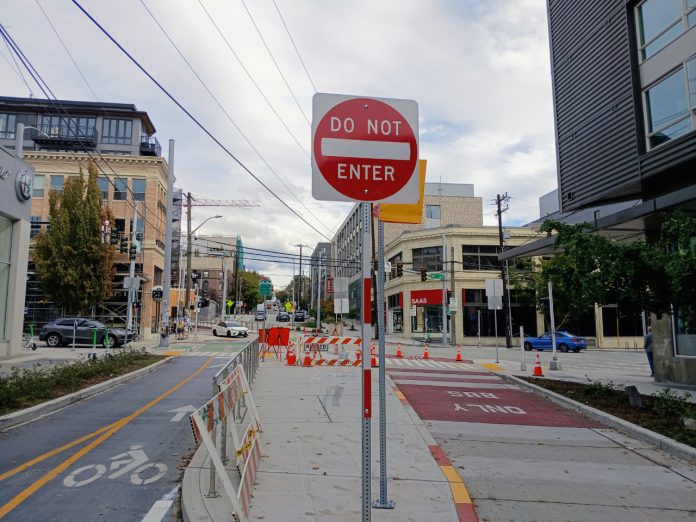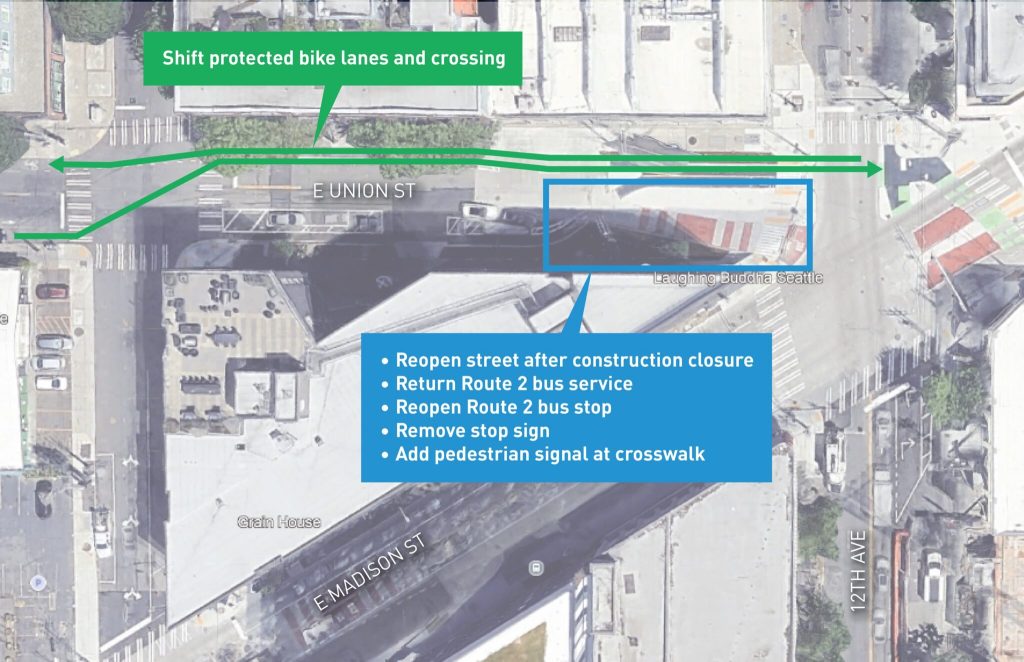
The Seattle Department of Transportation (SDOT) has backed off plans to remove a bus-only lane in Capitol Hill following quick mobilization by transit riders this week. The stretch of dedicated bus lane for westbound Route 2 buses at 12th Avenue and E Union Street needs adjustments to fully accommodate King County Metro’s operations, but the idea of opening it up to general purpose traffic at the same time had been quietly wrapped up in those changes.
Since late Tuesday, when The Urbanist first confirmed that SDOT planned to start work on removing the bus only lane markings as soon as this weekend, transit advocates had activated to push back on that plan. Volunteers with the Transit Riders Union organized a rally at the work site on Saturday morning, and a letter-writing campaign was launched within hours.
In a city where adding a bus lane can often take years — if it’s able to move forward at all — riders weren’t letting this one go without a fight.
Transit Riders Union head Katie Wilson is running for mayor and giving incumbent Bruce Harrell a strong challenge. In the August primary election, she led by nearly 10 points. Wilson has criticized Harrell’s inaction on bus lanes and improving transit operations, and she partook in the “Race the L8” event this summer that sought to draw attention to the perpetually late Route 8 bus by racing it on foot, with participants conga-lining, hopscotching, and so forth.
Thursday’s announcement came after what was a clear scramble at city hall to respond to that advocacy. The fact that the issue was on the table at all clearly took many policymakers by surprise, including citywide councilmember Alexis Mercedes Rinck, who lives nearby.
On top of that, SDOT’s statement to both The Urbanist and Capitol Hill Seattle framed the change as one intended to benefit drivers coming from Madrona, Madison Park, and the Eastside, a fact that many found baffling and hard to square with the city’s own goals around encouraging transit use. Capitol Hill residents and transit riders hadn’t even been given a chance to weigh in on this issue — though many likely did weigh in on the process for designing the RapidRide G Line, which took nearly a decade to come to fruition. This bus lane had been built along with that full corridor rebuild, with many riders patiently waiting for the chance to access the 2 at this stop for years.
Now, SDOT will move forward with adding a pedestrian signal for people crossing E Union Street, paving the way for King County Metro to feel comfortable using the stop rather than detouring around via E Pike Street. Without that signal, the intersection raised liability concerns related to who had the right-of-way — Metro’s operators could face conflicts with pedestrians if they make the turn from Madison at the same time someone starts to walk across Union. But opening up the lane to general purpose traffic is off the table — at least for now.
“As part of our efforts to support Metro Route 2’s use of this block, we are adding a pedestrian signal. It is standard practice to review and adjust how things are working after a major project, and one consideration is whether access to this short segment of E Union St could be expanded to accommodate specific needs of local businesses,” SDOT wrote in a blog post Thursday, admitting that the public process for this change had been short-circuited. “Unfortunately, this revised access was included in the current work plan before bus service resumed and before we had the chance to review outcomes that would help guide a decision.”

“When construction began to modify the E Union St bus lane, SDOT, Councilmembers Joy Hollingsworth and Alexis Mercedes Rinck, and the Mayor’s Office heard concerns from bus riders and those involved in planning the RapidRide G Project. We hear those concerns – and agree with feedback about the quick pace of work and the lack of communication about why the red bus lane markings were being removed and access for businesses was being added,” SDOT’s blog post continued. “That’s why we are updating our approach to meet the changes requested by Metro to support Route 2, while continuing conversations and evaluations with all stakeholders before advancing changes to bus lane uses.”
While the door remains open for the potential removal of the bus lane in the future, this announcement is a clear win for transit riders and nearby residents, who now have a seat at the table when it comes to the future of this stretch of street.
Ryan Packer has been writing for The Urbanist since 2015, and currently reports full-time as Contributing Editor. Their beats are transportation, land use, public space, traffic safety, and obscure community meetings. Packer has also reported for other regional outlets including BikePortland, Seattle Met, and PubliCola. They live in the Capitol Hill neighborhood of Seattle.

